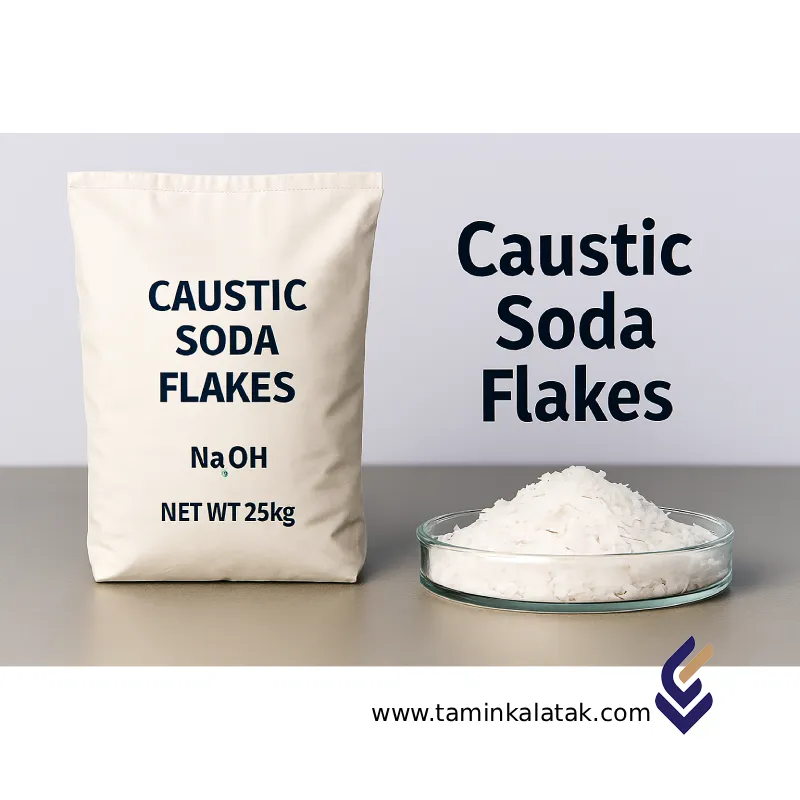Caustic soda Flakes
Caustic Soda Flakes, also known as solid sodium hydroxide (NaOH), is a highly caustic, strong alkaline compound appearing as white flakes. It is produced by evaporating a 50% caustic soda (liquid NaOH) solution.
This material reacts vigorously with acids, light metals, water, oils, and fats, and is widely used across chemical, petrochemical, detergent, food, textile, and oil & gas industries.
Chemical Structure of Caustic Soda Flakes
-
Chemical Name: Sodium Hydroxide
-
Chemical Formula: NaOH
-
Ionic Structure: Na⁺ and OH⁻ ions in an orthorhombic crystal lattice
-
CAS Number: 1310-73-2
-
EC Number: 215-185-5
-
Molecular Weight: 40.00 g/mol
Physical and Chemical Properties
| Property | Description |
|---|---|
| Physical State | White solid flakes |
| Melting Point | 318°C |
| Boiling Point / Decomposition | 1,388°C (decomposes to Na₂O and H₂O at high temperatures) |
| Density | 2.13 g/cm³ |
| pH (1% aqueous solution) | 13 – 14 |
| Solubility in Water | Highly soluble; exothermic reaction upon dissolution |
| Reactivity | Extremely reactive with water, acids, and light metals (e.g., aluminum, zinc) – releases flammable hydrogen gas |
| Odor / Viscosity | Odorless; non-viscous (solid form) |
Applications of Caustic Soda Flakes
Detergent and Cleaning Industries
-
Manufacturing of solid and liquid soaps, dishwashing liquids, degreasers, bleaches, and disinfectants
-
Fat and oil removal in industrial wastewater treatment
Oil, Gas, and Petrochemical Industries
-
Neutralization of acids in various processes
-
Sweetening of crude oil and natural gas (removal of H₂S and CO₂)
-
Regeneration of ion-exchange resins
Pulp, Paper, and Textile Industries
-
Used in the Kraft process for separating cellulose fibers from wood
-
pH control during dyeing, washing, and bleaching
Food Industry (Food Grade – E524)
-
CIP (Cleaning in Place) for pipelines and storage tanks
-
Used in chocolate, ice cream, soft drinks, and olive curing (in very small, controlled doses)
Metal and Surface Treatment
-
Polishing and etching of aluminum surfaces
-
Metal extraction from ores
-
Scale removal and cleaning of industrial equipment
Advantages of Caustic Soda Flakes
-
Highly effective in neutralizing acids and fats
-
Low cost and readily available in bulk quantities
-
Versatile – applicable across numerous industries
-
Long-term stability when stored in dry conditions
-
Flake form allows for easier handling, dosing, and storage
Disadvantages of Caustic Soda Flakes
-
Highly corrosive to skin, eyes, and many metals
-
Exothermic reaction with water → risk of chemical burns
-
Hygroscopic – absorbs moisture from the air, leading to caking
-
Requires alkali-resistant equipment for handling and transfer
-
Corrosive to seals, valves, and light metal fittings
Safety and Handling Information
-
GHS Classification: Corrosive – H314 (Causes severe skin burns and eye damage) – GHS Class 8
-
Personal Protective Equipment (PPE):
-
Gloves: Neoprene or PVC
-
Eye Protection: Safety goggles or face shield
-
Respiratory Protection: Mask or respirator for dust exposure
-
Clothing: Alkali-resistant lab coat or apron
-
-
First Aid Measures:
-
Skin/Eye Contact: Rinse immediately with plenty of water (at least 15 minutes) and seek medical attention
-
Inhalation of Dust: Ensure proper ventilation; use filter respirator in enclosed areas
-
Storage and Compatibility
| Parameter | Recommended Condition |
|---|---|
| Storage Environment | Cool, dry, well-ventilated area |
| Packaging | Moisture-proof triple-layer polypropylene bags (typically 25 kg) |
| Compatibility | Keep away from acids, light metals, nitrogenous and halogenated organic compounds |
| Handling Precautions | Avoid contact with water; prevent exposure to moisture and humidity |
Packaging and Transport
-
Standard Packaging: 25 kg moisture-resistant PP bags with inner liner
-
Transportation: Non-flammable but classified as Corrosive (GHS Class 8) — handle with appropriate labeling and containment
Applications
| Applications | , , , , , |
|---|
Caustic soda Flakes
| Products | Chemical formula | CAS number | Solubility in water | Grade | Vapor pressure | Melting point | Physical appearance | Density (at 20°C) |
|---|---|---|---|---|---|---|---|---|
| Sodium Hydroxide – Caustic Soda Perk | NaOH | 1310-73-2 | ~1,110 g/L (very soluble – exothermic reaction) | Industrial Grade, Analytical Grade, Food Grade (E524) | Practically negligible | 318°C | White solid, in the form of flakes, odorless | 2.13 g/cm³ |







